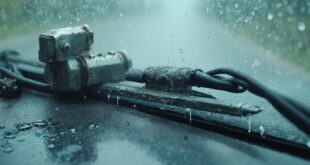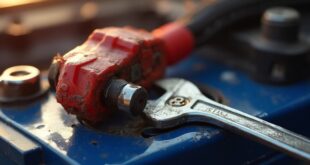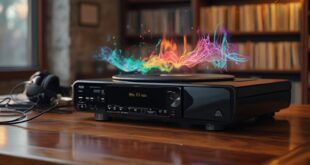To wire an ignition switch, start by gathering your tools and ensuring the engine is off. Disconnect the negative battery terminal and consult your vehicle's manual for terminal identification, usually labeled as BATT, ACC, ST, and IGN. Connect the positive lead to the BATT terminal, the accessory wire to ACC, the starter relay to ST, and the ignition wire to IGN. After assembly, reconnect the battery and test the switch's functionality. Continue on to discover more details about common issues.
Preparation and Safety Measures
Before you plunge into wiring an ignition switch, it's crucial to take a few important safety measures.
First, gather all necessary tools and equipment to streamline the process. Park your vehicle on level ground and engage the emergency brake. Make sure the engine is off before you begin. Review the vehicle's repair manual for specific instructions and have a wiring diagram handy.
Disconnect the negative battery terminal first to prevent any shocks, and make certain it doesn't touch the positive terminal. Wait a moment to let any residual charge dissipate, confirming a safe working environment before you proceed.
Identification of Ignition Switch Terminals
Identifying the ignition switch terminals is a critical step in the wiring process. Start by consulting your vehicle repair manual for terminal identification.
You'll typically find common terminals labeled as BATT, ACC, ST, and IGN. Keep in mind that newer vehicles may have additional terminals, so double-check the markings to avoid any mistakes.
If your manual isn't available, use online resources to find wiring diagrams. Confirm you accurately identify each terminal to facilitate proper connections later on.
Taking the time to verify this information can save you from potential wiring errors and electrical issues down the road.
Wiring Connections for Ignition Switch
With the ignition switch terminals properly identified, you're ready to make the necessary wiring connections.
Start by connecting the positive lead, usually red, to the BATT terminal. Next, attach the accessory wire to the ACC terminal for power. Connect the starter relay wire to the ST terminal, guaranteeing it's secure, and link the ignition wire to the IGN terminal for operation.
Use the appropriate gauge wire to prevent overheating. Double-check that all connections are tight and insulated.
Finally, test each connection with a multimeter to verify functionality before proceeding with reassembly. This will guarantee a reliable ignition system.
Reassembly and Testing of Ignition Switch
Once you've secured all wiring connections, it's time to carefully reinstall the ignition switch back into the steering column.
Make sure everything aligns properly and listen for the release pin to click into place. After that, you can reconnect the battery for testing.
Here's what to do next:
- Turn the key to the "on" position and check if the dashboard lights illuminate.
- Start the engine to confirm proper ignition function.
- Test accessories like the radio and air conditioning for correct operation.
If everything works as it should, you're all set!
Signs of Ignition Coil Issues
How can you tell if your ignition coil is failing?
First, pay attention to engine misfires or stutters during acceleration. If you're having difficulty starting the engine or it won't start at all, that's another sign.
You might also notice decreased fuel efficiency over time, which can indicate coil issues. Keep an eye on your dashboard—if the check engine light is illuminated, it's worth investigating.
Finally, listen for unusual engine noises like backfiring or popping. Addressing these signs early can save you from more extensive repairs down the road.
Types of Ignition Coils
Identifying the signs of a failing ignition coil can lead you to understand the different types available for your vehicle.
Choosing the right coil is essential for peak performance. Here are three types to evaluate:
- Coil-on-Plug (COP): Individual coils for each cylinder, enhancing efficiency and performance.
- Waste Spark Coil: Fires two cylinders simultaneously, improving fuel efficiency.
- Distributor Coil: Works with older distributor systems, distributing spark across cylinders.
Understanding these types helps you make informed decisions when replacing or upgrading your ignition system, ensuring your vehicle runs smoothly and efficiently.
Common Issues With Ignition Switches
While you might not think about it often, the ignition switch plays an essential role in starting your vehicle and powering its electrical systems. However, you may encounter some common issues that can be frustrating.
| Issue | Symptoms |
|---|---|
| Key won't turn | Difficulty starting or stuck key |
| Intermittent starting | Inconsistent electrical connection |
| No start despite charged battery | Complete failure to engage |
Addressing these problems early can save you time and trouble down the road. Keep an eye on your ignition switch's performance to guarantee smooth operation.
Frequently Asked Questions
What Tools Are Required to Wire an Ignition Switch?
To wire an ignition switch, you'll need wire strippers, a multimeter, insulated connectors, electrical tape, and a screwdriver. Having a wiring diagram handy will help guarantee you make the right connections safely.
How Can I Troubleshoot Ignition Switch Wiring Problems?
To troubleshoot ignition switch wiring problems, check for loose connections, corrosion, or damaged wires. Test the switch with a multimeter, ensuring continuity. If issues persist, consult your vehicle's manual for specific diagnostic procedures.
Can I Replace the Ignition Switch Myself?
Yes, you can replace the ignition switch yourself if you're comfortable with basic automotive tasks. Just make certain you've got the right tools, follow safety precautions, and consult your vehicle's manual for specific instructions.
What Are the Costs Involved in Replacing an Ignition Switch?
When replacing an ignition switch, you'll encounter costs like the switch itself, labor charges if you hire a mechanic, and potential additional fees for related parts. Budget around $100 to $500 depending on your vehicle.
How Long Does It Take to Wire an Ignition Switch?
Wiring an ignition switch usually takes about one to two hours, depending on your experience and the vehicle's complexity. You'll need to guarantee you follow safety measures and have the right tools handy for efficiency.
 Car Service Land Coupons for Oil change, Tires, Wheel alignment, Brakes, Maintenance
Car Service Land Coupons for Oil change, Tires, Wheel alignment, Brakes, Maintenance




